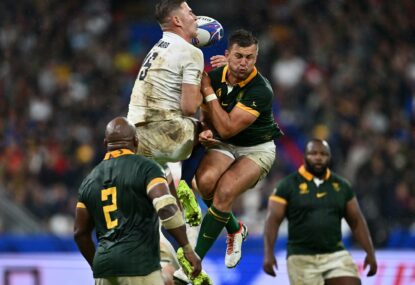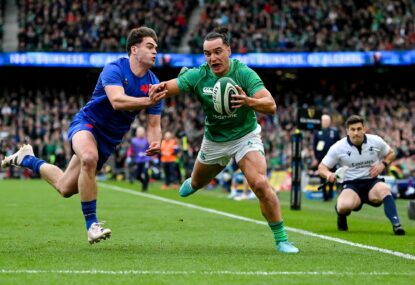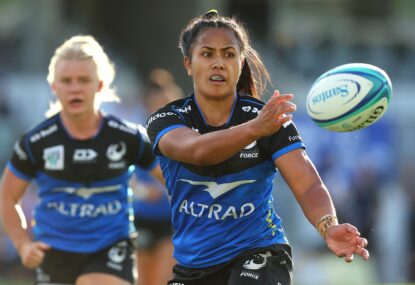“We go again.” Since 2016 these three simple words, screamed by players and captain alike, symbolise the England way.
Dylan Hartley repeated it in the changing rooms after the Australia tour. Billy Vunipola screamed this to his players before their final first-half scrum against Ireland. It has become something of a motto, a war cry to drive the players to a higher mindset.
The drive to become relentless.
Ireland are an incredibly efficient and technically superior team. They do the basics and fine details to a level far beyond any other rugby team.
But England came to play. Under their arm they brought a fury for the fight and their new philosophy to launch against Ireland. The result was one of the finest performances by an England team since November 2012.
This performance was built on the England defence. As such, we’ll investigate the dynamics of the new England way in defence and why Eddie Jones has now fallen back to this as the cornerstone of the game.
The England way: England in defence
John Mitchell can be very proud. His defence was sensational.
England made an unprecedented number of dominant tackles, and there was little to be done about the power of the defensive line England brought to bear. Their desire to get off the line, to get back in, to make bone-crunching tackles, was relentless.
The John Mitchell defence is in areas remarkably similar to the All Blacks ‘whip’ defence, the dynamics of which will be shown in a future article.
Watch this clip and another short excerpt of the Ireland vs All Blacks match. Hopefully you can see the similarities with this clip and the following video.
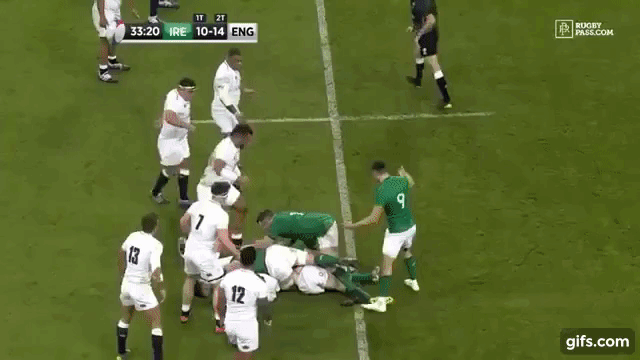
There is a higher onus on physicality, but what I really have to admire is the street smarts enlightened on the players by Mitchell in their technical skills.
The make-up
England are happy to give the opposition the overlap in their new system. Generally their tight five and pack are stationed closer to the ruck, with their backline players further out to act as the speed men in case they are outflanked. The tight five, as you can see here, get through so much work in defence it’s scary.
What England are counting on, however, is limiting the opposition earning the right to go wide. This means the priority for England are opposition ‘one-out’ pods.
England station their heaviest players here, the principle being if you target hard here, you will cut off near all wide attacks before they can be launched.
As we saw all day against Ireland, if wide plays are launched off back football, the defensive line has had time to reset. They’ll be on you before the ball can get past the 13 channel. That means not only do the attacks not achieve their aim, but you’re far further back than you were before.
England were outflanked on occasions and the gainline was broken, but the instances were few and far between. The majority of the time they had time to reset, realign and go again.
For the whole game they were assisted by some of the dynamics built into the defence. Let’s take a look at them.
The double hit
England’s defence is based on dominant tackles. They will constrict their line and happily give the overlap if it means making dominant tackles. This is their defensive foundation.
This means they hunt in twos. Everything the tacklers do is meant to destabilise and delay the opposition ruck speed. Ireland’s breakdown is the best in the world. This is mainly due to their carriers falling in a position where they can immediately present the ball with no adjustment. England’s double hit dynamic didn’t allow this.
The England way: Ireland 2019
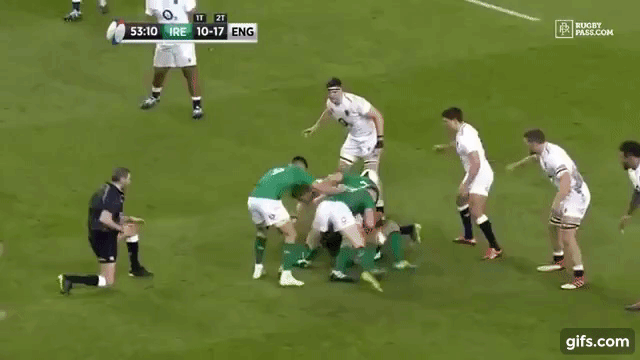
England retain their chop tackle options, but an extra addition we’ve seen is the use of higher tackles. In a lot of one-out tackles the first hit from the first tackler is designed to direct the tackler ‘up’. This is especially prevalent against upright runners. Straight from England’s judo seminars, an opponent is always weaker with a higher centre of gravity. This first hit lengthens the carrier.
This hit means they’re contained and latched onto, stopping the momentum. The second tackler then cradles the arms and either holds up for the maul or drives hard, taking advantage of their unstable position and grounding the carrier on their terms, as we can see clearly in the second double hits. Their arms are still around the ball, slowing delivery and the ruck and allowing the defence to reset.
This is not the first game we’ve seen this.
The England way: New Zealand 2018
The All Blacks were introduced to the double hit as well and, as was can see, the lessons learnt were put in place for Ireland.

Maro Itoje directs Julian Savea up, allowing Owen Farrell to come in for the rip.
Not happy with Jonny May’s intervention, Kyle Sinckler makes sure the tackle fast becomes dominant.
New Zealand are so sick of double hits by this point that Damian McKenzie clears Farrell out before he can affect it.
Plaudits must go to Mark Wilson, who over the autumn internationals came in as the second tackler so many times to such destructive effect that he has played himself into the starting 15.
The result
This new defensive system is susceptible to quick ball, but England’s defence near squashes any chance of it. The urge England now have to double hit also results in mauls, which Ireland conceded against. Due to their accuracy at the breakdown, this hardly ever happens, yet England did it. If they keep slowing the ball down at the source, they can realign in time and go again.
The effects of slowing the ball down can be seen here. England reset and gain near 20 metres and a penalty.
Courtney Lawes here targets Garry Ringrose, not buying the outside post setup. England have done their homework.
Yet again we see Lawes make the tackle. As it isn’t dominant enough, another man comes in to hit. Who else but the indomitable Mark Wilson.
With one-out runners contained with dominant hits, the opposition can only kick.
With players like May, Elliot Daly and Joe Cokanasiga in the backfield too, England will go again.
Opposition teams will not like that.
































































































